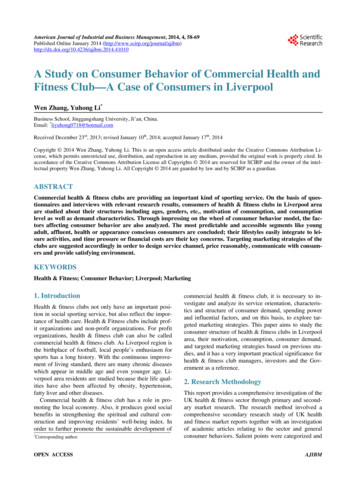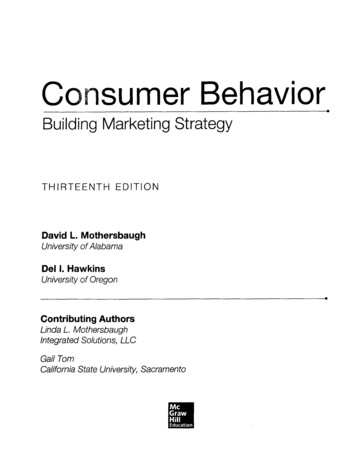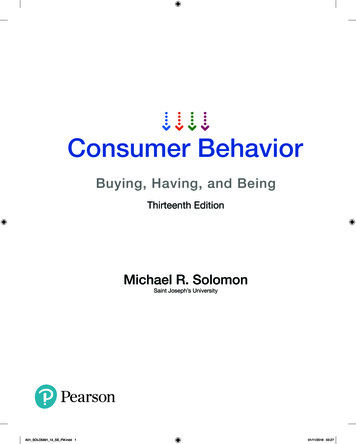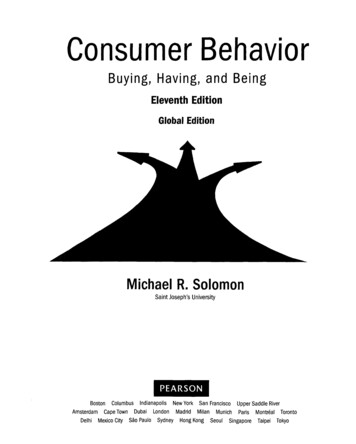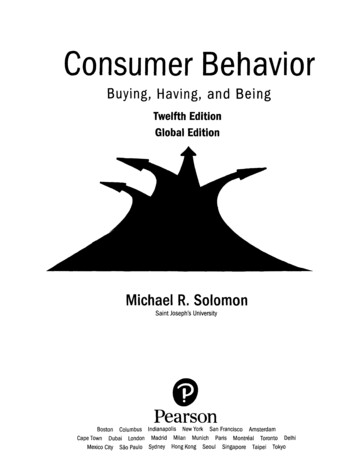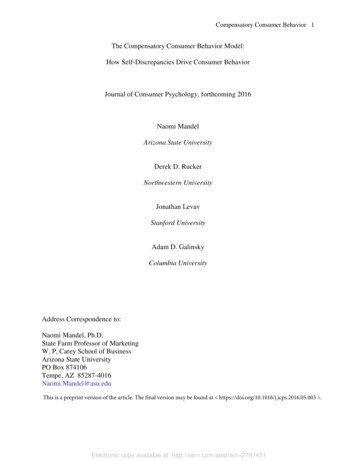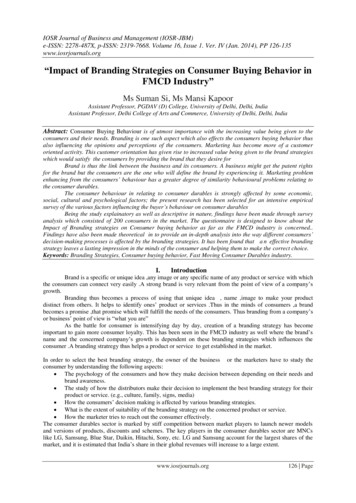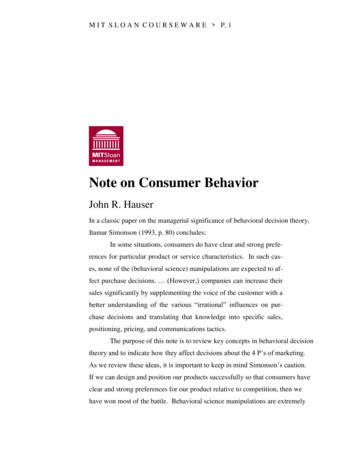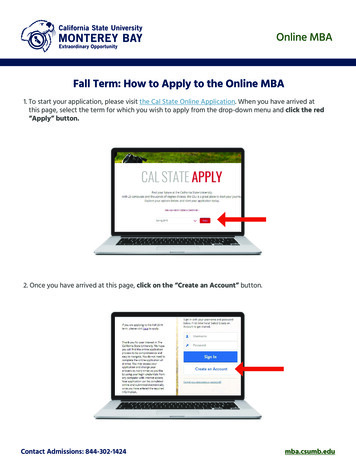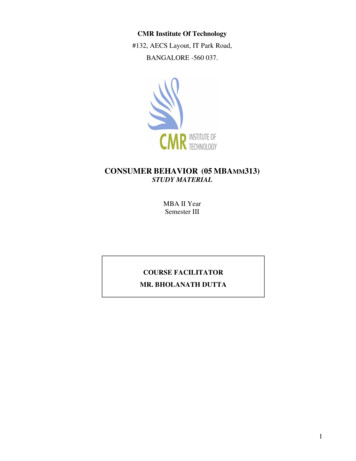
Transcription
CMR Institute Of Technology#132, AECS Layout, IT Park Road,BANGALORE -560 037.CONSUMER BEHAVIOR (05 MBAMM313)STUDY MATERIALMBA II YearSemester IIICOURSE FACILITATORMR. BHOLANATH DUTTA1
MODULE- IINTRODUCTION TO THE CB:Definition:“CB behaviour refers to the actions and decision processes of people who purchase goods andservices for personal consumption.”- James F Engel, Roger D Blackwell and Paul Miniard.“The mental and emotional processes and the physical activities of people who purchase and usegoods and services to satisfy particular needs and wants”- Bearden et al.“The behaviour that consumers display in searching for, purchasing, using, evaluating anddisposing of, if products and services that they expect will satisfy their needs.”- Leon G Schiffmanand Leslie Lazar KanukSelected Consumer Behaviour rUser(s)DescriptionInitiator is the individual who determines that some need or want is notbeing fulfilled and authorises a purchase to rectify the situation.Influences the family’s processing of information. The gatekeeper has thegreatest expertise in acquiring and evaluating the information.Influencer is a person who, by some intentional or unintentional word oraction, influences the buying decision, actual purchase and/or the use ofproduct or service.The person or persons who actually determine which product or service willbe chosen.Buyer is an individual who actually makes the purchase transaction.User is a person most directly involved in the use or consumption of thepurchased product.The diversity of CB:Human being differs from one to another. It is not easy to predict the human behaviour. Humanbeing differs in their taste, needs, wants and preferences. But one constant thing is that we all areconsumers.CB is a vast and complex subject. Understanding CB and “knowing consumers’ are not that simple.It is almost impossible to predict with one hundred per cent accuracy, how consumer(s) will behavein a given situation. Marketers are interested in watching people shopping, flirting, parading,playing, entertaining, as they are keenly interested in the wide variety of behaviours they display.The efforts of all marketers are to influence the behaviour of consumers in a desired manner. Thesuccess or failure in this pursuit determines the difference between success and failure of marketingefforts or even the business itself.2
Why we study of CB:The term CB is defined as the behaviour that consumers’ display in searching for, purchasing,using, evaluating and disposing of products and services that they expect will satisfy their needs.CB focuses on how individuals make decisions to spend their available resources (time, money,effort) on consumption related items.The term CB describes two different kinds of consuming entities: the personal consumer and theorganizational consumers. The Personal consumer buys goods and services for his or her own use,for the use of the household or as a gift for a friend. In each of these contexts, individuals, who arereferred to as end users or ultimate consumers, buy the products for fine use.The second category of consumer- the organizational consumer- includes profit and not-for-profitbusinesses, government agencies (local, state, and national), and institutions (e.g. Schools, hospitals,and prisons), all of which must buy products, equipments and services in order to run theirorganization.Why the field of CB developed:In order to succeed in any business, and especially in today’s dynamic & rapidly evolving marketplace, marketers need to know everything they can about consumers – what they want, what theythink, how they work, how they spend their leisure time. The field of CB is rooted in the Marketingconcept. Production conceptProduct conceptSelling ConceptMarketing concept- CB developed from this concept. Here everything is executed from thepoint of view of Consumer.Ethics of Marketing & Corporate Environment:No environmental degradation- less promotion for tobacco & drug- the societal marketing conceptrequires that all marketers adhere to principles of social responsibility in the marketing of theirgoods & services. According to the societal marketing concept, fast-food restaurants should developfoods that contain less fat and starch and more nutrients, and marketers shouldn’t advertisealcoholic beverages or cigarettes to young people, or use young models or professional athletes inliquor or tobacco advertising.Some critics are concerned that an in-depth understanding of CB makes it possible for unethicalmarketers to exploit human vulnerabilities in the market place and engage in other unethicalmarketing practices in order to achieve individual business objectives. As a result, many tradeassociations have developed industry wide code of ethics.Business School Education:Consumers also stand to benefit directly from orderly investigations of their own behaviour. Thiscan occur on an individual basis or as part of more formal educational programs. As we study whathas been discovered about the behaviour of others, we can gain insight into out own interactions3
with the marketplace. For example, when we learn that a large proportion of the billions spendannually on grocery products is used for impulse purchases, and not spent according to pre-plannedshopping lists, we may be more willing to plan our purchases in an effort to save money. In general,as we discover the many variables that can influence consumers’ purchases. We have theopportunity to understand better how they affect our own behaviour.What is learned about consumer behaviour can also directly benefit consumers in a more formalsense. The knowledge can serve as data for the development of educational programs designed toimprove consumers’ decision-making regarding products and services. Such courses are nowavailable at the high school and college level and are becoming increasingly popular. To be mosteffective, these educational programs should be based on a clear understanding of the importantvariables influencing consumers.Consumer Movement:Marketing evolved through production concept to marketing concept. And marketing concept isnothing but consumer-oriented approach. Until company satisfy the needs and wants of consumerthe whole efforts to bring the product in the market fails. Companies had to engage in extensivemarketing research to identify unsatisfied consumer needs. In this process, marketers learned thatconsumers were highly complex as individuals had very different psychological and social needs,quite apart from their survival needs. They also discovered that needs and priorities of differentconsumer segments differed significantly. They realised that to design products and developsuitable marketing strategies that would satisfy consumer needs, they had to first study consumersand the consumption related behaviour in depth. In this manner, market segmentation and marketingconcept paved the way for the application of consumer behaviour principles to marketing strategy.Consumer Research:(A) Consumer researchers today use two different types of RM to study CB(i)Quantitative Research: It is also known as positivism – researchers are known aspositivist. The research methods used in positivist research are borrowed primarily fromthe natural sciences and consist of experiments, survey techniques and observation. Thefindings are descriptive, empirical and, if collected randomly (using a probabilitysample) can be generalized to larger population.(ii)Qualitative Research: It is also known as interpretivism. Researchers are also known asinterpretivists. Among the RM they use are depth interviews, projective techniques, andother methods borrowed from cultural anthropology. Broadly speaking, the findings ofqualitative research cannot be generalized to large population.Marketers have discovered that these two research paradigms are really complementary in nature.The prediction made possible by positivist research together produce a richer and more robustprofile of consumer behaviour than either research approach used alone.4
(B) The consumer research process:Steps in Consumer Research Process:Consumer ResearchObjectiveSecondary DataCollectionSufficientInsightYesPrepare reportNoDesign Primary researchQualitative research- Method- Questionnaire- Discussion guideQuantitative research- Method- Sample design- Data CollectionConduct research(Use highly trainedInterviewers)Collect primary data(Use field staff or hireprofessionals)Analyse data(Subjective)Analyse data(Objective)Prepare report(i)Prepare reportDeveloping research objectives:A carefully thought out statement of objectives helps to define the type and level of informationneeded. Is it to find out consumer attitudes about online shopping? To determine what percentage ofhouseholds e-mail?5
(ii)Collecting Secondary Data:Internal sources: P&L statement, balance sheets, sales figure, and prior research report.External sources: Govt publication, periodicals and books & commercial data.(iii)Designing primary research:Quantitative research designs: Three Basic RD used here are Observational Research:OR is an important method of consumer research because marketers recognize that the best way togain an in-depth understanding of the relationship between people & product is by watching them inthe process of buying and using products. Many large corporations and advertising agencies usedtrained researchers/observers to watch note & sometimes videotape consumers in stores, malls ortheir own homes.Mechanical observation like security cameras in ATM counter to observe problems customer mayhave in using ATMs. Experimentation:The best example is shopping mall; we can judge the consumers inside about how long respondentsspend in looking at the product, the time spent in examining each side of the package, the productspurchased, and the order of the purchases. Surveys:If researchers wish to ask consumers about their purchase preferences and consumption experiencesthey can do so in person, by mail, by telephone or online through questionnaire.Qualitative RD & Data Collection Method: Depth Interview:It is a lengthy (generally 30mnts to an hour) non-structured interview between a respondent and ahighly trained interview between a respondent and a highly trained interviewer. Respondents areencourages to talk freely about their activities, attitudes and interest to the product category orbrand under study. Focus Group:Consists of 8 to 10 respondents who meet with a moderator-analyst for a group discussion“focussed” on a particular product or product category. Respondents are encouraged to discuss theirinterests, attitudes, reactions, motives, life styles, feelings about the product or product category,usage experience and so forth.6
Projective Techniques:Designed to tap the underlying motives of individuals. They consist of a variety of disguised teststhat contain ambiguous stimuli, such as in complete sentences, untitled pictures or cartoons, workassociation test.(i)Thematic Apperception Test (TAT): respondents are shown pictures or cartoonsconcerning the product or the topic under study and asked to describe what ishappening in the picture. It is believed that respondents will actually reveal their ownmotivations, attitudes, personalities and feelings about the situations.(ii)Word Association Test: This is a relatively old and simple technique. Respondentsare read a series of words or phrases, one at a time and asked to answer quickly withthe first word that comes into mind after hearing each one. By responding in rapidsuccession, it is assumed that they indicate what they associate most closely with theword or phrase spoken and reveal their true feelings.(iii) Sentence Completion Test: The interviewer reads the beginning of a sentence andthe respondent is required to finish it. This technique is believed to be useful inuncovering the images consumers have about products and stores. The informationcollected can be used to develop promotional campaigns.(iv)The Third Person Technique: The interviewer asks the respondent to describe athird person. For this, respondents are presented with some information about theperson. It is believed that when they describe a neighbour or a third person, theyusually respond without hesitation and in doing so, they express their own attitudesor motives as they infer the attitudes or motives of someone else.(iv)Sampling & data collection:Probability sampling – Non-probability sampling.(v)Data analysis and reporting research findings:In qualitative research, the moderator or test administrator usually analyses the responses received.In quantitative research, the researcher supervises the analysis.(vi)Report Preparation:In both qualitative & quantitative research, the research report includes a brief executive summaryof the findings. Depending on the assignment from marketing management, the research report mayor may not include recommendations for marketing action.The body of the report includes a full description of the methodology used and for quantitativeresearch, also includes tables and graphics to support the findings. A sample of the questionnaire isusually included in the appendix to enable management to evaluate the objectivity of the findings.7
MODULE – IICONSUMER AS AN INDIVIDUAL:Consumer needs and Motivation:Motivation: Basic drive in the individual, which enable a man to act in a particular way, ion ReducedAnother NeedDevelopNeeds: Every individual has needs. Innate Needs: Physiological (food, water, air, clothing, shelter,sex). It is called primary needs also. Acquired Needs: We learn in response to our culture orenvironment. Self-esteem, prestige, affection, power, learning. Because, acquired needs aregenerally psychological. They are considered secondary needs.Goals: Goals are the sought-af
CONSUMER BEHAVIOR (05 MBAMM313) STUDY MATERIAL MBA II Year Semester III COURSE FACILITATOR MR. BHOLANATH DUTTA . 2 MODULE- I INTRODUCTION TO THE CB: Definition: “CB behaviour refers to the actions and decision processes of people who purchase goods and services for personal consumption.”-James F Engel, Roger D Blackwell and Paul Miniard. “The mental and
